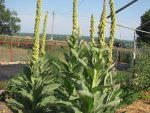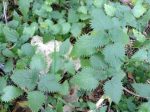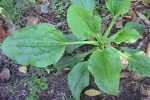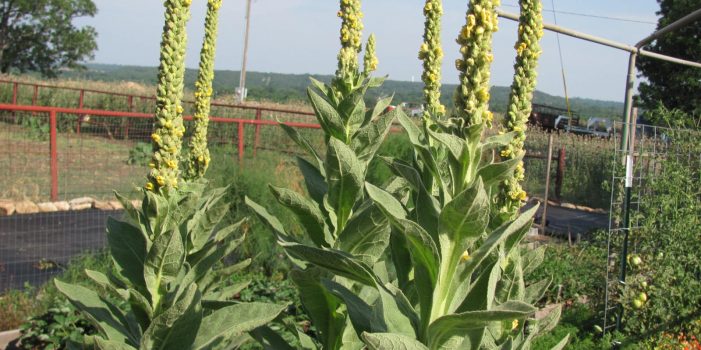We are taking a look at common weeds that can be used as food and medicine. If things go very wrong, such as in an EOTWAWKI or SHTF scenario, you may find yourself without access to doctors and hospitals and may have to take care of yourself and your family. You may want to print this and save it for such a time, when things are stressful and you may not remember the information here.
Warning: Never eat a wild plant unless you are 100 percent positive of its identification. Get yourself a good field guide, like Edible Wild Plants – A North American Field Guide.
Parts 1 & 2 covered chickweed, cleavers, dandelion, lamb’s quarters, lobelia, mallow, and miner’s lettuce. We’ll now move on forward through the alphabet of most common weeds for food and medicine, beginning with mullein.
Mullein
Mullein is found all over in North America and is exceedingly abundant. It is found growing on by roadsides and on waste ground, sunny positions in uncultivated fields and especially on dry soils. However, please do not harvest Mullein right next to roads; all kinds of things leak from cars and then wash out into the soil when it rains.
Properties
 Mullein is an easily-grown plant. It succeeds in most well-drained soils, including dry ones, and prefers a sunny position. Mullein dislikes shade and wet soils.
Mullein is an easily-grown plant. It succeeds in most well-drained soils, including dry ones, and prefers a sunny position. Mullein dislikes shade and wet soils.
The leaves, during the first season, at the base of the stem form a rosette. They are numerous, large, 6 to 15 inches long, and up to 5 inches broad but then become smaller as they ascend the stem, on which they are arranged on alternate sides. Leaves are whitish with a soft, dense mass of hairs on both sides, which make them feel very furry and thick. The root is a long taproot with a fibrous outer cover and fleshy inside. The flower-spike, which comes in the second season blooming during July and August, has been known to attain a height of 7 or 8 feet, covered with densely crowded, sulphur-yellow flowers about an inch across with five rounded petals. Harvest the entire plant when in bloom and dry for later herb use.
Medicinal Use
Mullein has been used as an alternative medicine for centuries, and the value of Mullein as a proven medicinal herb is now backed by scientific evidence. Research indicates some of the uses as: analgesic, anti-inflammatory, antihistaminic, anti-cancer, antiseptic, antispasmodic, astringent, demulcent, diuretic, emollient, expectorant, sedative, and vulnerary. It’s a pretty useful herb for something that grows wild and free, wouldn’t you say?
An infusion is taken internally in the treatment of a wide range of chest complaints and also to treat diarrhea and bleeding of the lungs and bowels. The leaves, root, and the flowers are anti-inflammatory. Mullein oil is a very medicinal and valuable destroyer of disease germs. An infusion of the flowers in olive oil is used as earache drops or as a local application in the treatment of hemorrhoids and other mucous membrane inflammations. This infusion is a strong antibacterial. The oil, being used to treat gum and mouth ulcers, is very effective.
A decoction of the roots is used to alleviate toothache. It can also relieve cramps and convulsions.
They can be employed with equal benefit when smoked. (Yes, I said smoked, even though that sounds counter-intuitive. To avoid inhaling the burning paper, I’d use a pipe.) It can be smoked to relieve the irritation of the respiratory mucus membranes and the hacking cough of tuberculosis, as well as for asthma and spasmodic coughs in general. Externally, a medicinal poultice of the leaves is applied to sunburn, ulcers, tumors and piles. The whole plant possesses slightly sedative and narcotic properties. The seeds are considered toxic. They have been historically used as a narcotic.
The dried leaves are highly flammable and can be used to ignite a fire quickly, or as wick for candles.
Recipes and Doses
An aromatic, mullein tea can be made by boiling 1 Tbsp. dried leaves or root in 1 cup water, and steep for 5–10 minutes. A sweeter tea can be made by infusing the fresh or dried flowers. For children and the elderly, use milk instead of water to make the tea. Sweeten if desired.
For chest complaints, smoke the leaves. First year leaves are the best.
To make mullein oil, use flowers or root. Place in blender or crush, fill jar, cover with olive oil, set in warm place for two weeks. Strain before use.
Poisonous Look Alikes
Poisonous look alikes include comfrey and foxglove. Note that comfrey is not really poisonous, but in larger internal doses it can cause liver problems. Foxglove has been used for centuries for heart ailments but in very small quantities and under the care of someone who knows what they are doing. Foxglove is potent; ingesting .5 grams dried or 2 grams fresh could be deadly.
Nettles
Nettles (urtica dioica) is better known as stinging nettles. It gets this name for good reason.
Properties
 These plants have little hollow hairs that break off when touched and contain several compounds that cause painful stinging. Therefore, picking nettles should be done while wearing long sleeves and rubber gloves. Regardless of the sting, you are going to want to pick some of these (with the aforementioned safeguards) because nettles are both nutritious and medicinal.
These plants have little hollow hairs that break off when touched and contain several compounds that cause painful stinging. Therefore, picking nettles should be done while wearing long sleeves and rubber gloves. Regardless of the sting, you are going to want to pick some of these (with the aforementioned safeguards) because nettles are both nutritious and medicinal.
Oh, and by the way, if you do get stung, grab a plantain leaf (next herb down our list), bruise it, and rub the juice over the sting; the pain is relieved almost instantly. Other herbs that will reduce or entirely reduce the sting are dandelion, horsetail, leaf of dock (sheep sorrel, yellow or curled dock, although not burdock, which is a member of the aster family), and jewelweed.
Once dry, the hairs will no longer sting you. Nettles make both a delicious tea as well as being a very tasty pot herb. As a pot herb, nettles tastes similar to spinach and cucumber when cooked, and it is rich in vitamins A, C, iron, potassium, manganese, and calcium. It is best picked and eaten in the spring before flowering.
Nettles is listed as one of the 30 best herbs by the herbalists of the California School of Herbal Studies.
Medicinal Uses
Medicinally, nettles are excellent for arthritis and rheumatism, reducing inflammation, treatment of the kidneys and urinary tract– bladder infections and kidney stones (a great diuretic), gastrointestinal tract, cardio-vascular system, and high blood pressure, hemorrhage, flu (reduces inflammatory cytokines), sciatica, bursitis, tendinitis, and gout.
Nettle tea taken regularly helps reduce allergies and the symptoms of allergies and can even help with asthma. My husband is really allergic to cottonwood. I start him each year on daily nettle tea in March to reduce his reaction when the cottonwood starts blooming in May.
For men, nettle root treats symptoms of benign enlargement of the prostrate and increases free testosterone. For nursing women, it promotes lactation. Nettle shampoo is great for preventing baldness and dandruff.
Recipes and Doses
To make nettle tea, use 1 Tbsp per cup of boiling water. Allow to steep for 5–10 minutes. Sweeten it, if desired.
For soup, bring a pot of water to boil. Add nettles and allow to stew for a few minutes. Strain nettles from the liquid, and then strain liquid to remove any dirt or debris. Make a roux with butter and flour, and then add back the strained water. Chop nettles finely and add back to roux/water mixture. Add chives, onion, garlic, chervil, or fennel, if desired.
As a pot herb, cook nettles in a little water. Use it the same as spinach.
Nettles can also be boiled and the resulting liquid used for a coagulant for making cheese.
Poisonous Look Alikes
Nettles has no poisonous look alikes.
Plantain
Plantain (Plantago major and Plantago lanceolata) is a perennial herb. It’s considered a common and noxious weed by some and a miracle plant by others. There are several varieties of plantain; both have similar qualities.
Properties
 Plantain is very easy to cultivate. It succeeds in any soil and prefers a sunny spot. Harvest fresh young edible leaves in spring. Gather plantain after flower spike forms; dry for later herb use.
Plantain is very easy to cultivate. It succeeds in any soil and prefers a sunny spot. Harvest fresh young edible leaves in spring. Gather plantain after flower spike forms; dry for later herb use.
I make very sure I know exactly where on my property it is growing, in the case of a bee, wasp, or hornet sting. In that case, I take a leaf or two, chomp it a little bit, and apply it directly to the sting. It relieves the pain and swelling nearly instantly. I usually go into the house and grab a Band-Aid and use that to hold it over the sting for a few hours.
Plantain is edible and medicinal, the young leaves are edible raw in salad or cooked as a pot herb. They are very rich in vitamin B1 and riboflavin.
Medicinal Use
The herb has a long history of use as an alternative medicine dating back to ancient times. Being used as a panacea (medicinal for everything) in some cultures, one American Indian name for the plant translates to “life medicine”, and recent research indicates that this may not be far from true!
The leaves and the seed are medicinally used as an antibacterial, antidote, astringent, anti-inflammatory, antiseptic, cough suppressant; for cardiac treatment, soothing and protecting mucous tissues, stopping bleeding; as a diuretic, expectorant, laxative, poultice; for bringing down fever and killing or expelling worms. Medical evidence exists to confirm uses as an alternative medicine for asthma, emphysema, bladder problems, bronchitis, fever, hypertension, rheumatism, and blood sugar control.
A decoction (strong tea) of the roots is used in the treatment of a wide range of complaints, including diarrhea, dysentery, gastritis, peptic ulcers, irritable bowel syndrome, hemorrhage, hemorrhoids, cystitis, and bronchitis, inflammation of mucous membranes, sinusitis, coughs, asthma, and hay fever.
It also causes a natural aversion to tobacco and is currently being used in stop smoking preparations.
Plantain is a safe and effective treatment for bleeding. It quickly stops blood flow and encourages the repair of damaged tissue by stimulating cellular growth and tissue regeneration. The heated leaves are used as a wet dressing for wounds, skin inflammations, malignant ulcers, cuts, stings, and swellings, and they are said to promote healing without scars. Poultice of hot leaves is bound onto cuts and wounds to draw out thorns, splinters, boils, and inflammation. The root is said to be used as an anti-venom for rattlesnake bites.
Plantain seeds contain up to 30% mucilage which swells in the gut, acting as a bulk laxative and soothing irritated membranes. The seeds are used in the treatment of parasitic worms.
I make a salve from chickweed, plantain, and comfrey and sometimes St. John’s Wort to use for diaper rash and to cover scratches and cuts.
Poisonous Look Alikes
Plantain has no poisonous look alikes.
Tomorrow, we will wrap up our list of common weeds as food and medicine.
See Also:
- 1- Common “Weeds” as Food and Medicine- Part 1, by M.C.
- 2- Common “Weeds” as Food and Medicine- Part 2, by M.C.
- 4- Common “Weeds” as Food and Medicine- Part 4, by M.C. (Active on 12/6/18)
SurvivalBlog Writing Contest
This has been part three of a four part entry for Round 80 of the SurvivalBlog non-fiction writing contest. The nearly $11,000 worth of prizes for this round include:
First Prize:
- A $3000 gift certificate towards a Sol-Ark Solar Generator from Veteran owned Portable Solar LLC. The only EMP Hardened Solar Generator System available to the public.
- A Gunsite Academy Three Day Course Certificate. This can be used for any one, two, or three day course (a $1,095 value),
- A course certificate from onPoint Tactical for the prize winner’s choice of three-day civilian courses, excluding those restricted for military or government teams. Three day onPoint courses normally cost $795,
- DRD Tactical is providing a 5.56 NATO QD Billet upper. These have hammer forged, chrome-lined barrels and a hard case, to go with your own AR lower. It will allow any standard AR-type rifle to have a quick change barrel. This can be assembled in less than one minute without the use of any tools. It also provides a compact carry capability in a hard case or in 3-day pack (an $1,100 value),
- Two cases of Mountain House freeze-dried assorted entrees in #10 cans, courtesy of Ready Made Resources (a $350 value),
- A $250 gift certificate good for any product from Sunflower Ammo,
- American Gunsmithing Institute (AGI) is providing a $300 certificate good towards any of their DVD training courses.
Second Prize:
- A Model 175 Series Solar Generator provided by Quantum Harvest LLC (a $439 value),
- A Glock form factor SIRT laser training pistol and a SIRT AR-15/M4 Laser Training Bolt, courtesy of Next Level Training, which have a combined retail value of $589,
- A gift certificate for any two or three-day class from Max Velocity Tactical (a $600 value),
- A Three-Day Deluxe Emergency Kit from Emergency Essentials (a $190 value),
- Two 1,000-foot spools of full mil-spec U.S.-made 750 paracord (in-stock colors only) from www.TOUGHGRID.com (a $240 value).
- An assortment of products along with a one hour consultation on health and wellness from Pruitt’s Tree Resin (a $265 value).
Third Prize:
- A Royal Berkey water filter, courtesy of Directive 21 (a $275 value),
- A large handmade clothes drying rack, a washboard, and a Homesteading for Beginners DVD, all courtesy of The Homestead Store, with a combined value of $206,
- Expanded sets of both washable feminine pads and liners, donated by Naturally Cozy (a $185 retail value),
- Two Super Survival Pack seed collections, a $150 value, courtesy of Seed for Security, LLC,
- Mayflower Trading is donating a $200 gift certificate for homesteading appliances.
Round 80 ends on January 31st, so get busy writing and e-mail us your entry. Remember that there is a 1,500-word minimum, and that articles on practical “how to” skills for survival have an advantage in the judging.











Great article!
In addition to Mullein, it is great for TP. And, nettles, particularly stinging nettle makes great cordage.
I would be cautious about using stinging nettles as TP.
Would it be possible to get a copy of this entire series as a .pdf or something? I would like to save it as a reference. Or is there an easier way to put all the installments together to print out?
I’ve heard of using mullein leaves to staunch bleeding. TP is a new one to me, but makes sense!
When viewing the article, there is a small icon under the title that looks like a printer. When you press that, the article will be reformatted in a printer friendly way. It also retains any weblink as a notation at the bottom so you can still find them even when the article is printed and offline.
Great, thanks!
This series deserves a win!